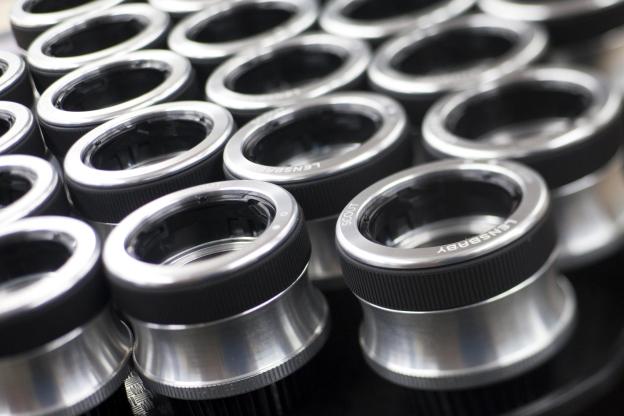 America has claims on some impressive technology — but camera lenses are not one of them and we have no bragging rights over the manufacturing business. That has long been an industry exported to Germany and Japan, where the conditions run the gamut. Some camera makers, like Zeiss, are known for their attention to detail and focus on each and every optic. Others take a more sterile, assembly line, cookie cutter technique to the practice. But to all of them, we’ve outsourced our lens business, part of the reason why quality glass is so very, very expensive. The issues of location and method are only two things pressuring an old industry that is begging for disruption.
America has claims on some impressive technology — but camera lenses are not one of them and we have no bragging rights over the manufacturing business. That has long been an industry exported to Germany and Japan, where the conditions run the gamut. Some camera makers, like Zeiss, are known for their attention to detail and focus on each and every optic. Others take a more sterile, assembly line, cookie cutter technique to the practice. But to all of them, we’ve outsourced our lens business, part of the reason why quality glass is so very, very expensive. The issues of location and method are only two things pressuring an old industry that is begging for disruption.
And Lensbaby is effectively and quietly doing just that. The Portland, Oregon-based camera creative lens manufacturer eschews what might be considered traditional setups in favor of a more personal — and more affordable — approach. The company was started in October 2003 by co-founders Craig Strong and Sam Pardue. Strong, a photographer, emphasizes that manufacturing was never his passion. “I’m not an expert on assembly or manufacturing,” he tells me. He began making his own lenses when he went digital in 2000, which became a jumping off point for Lensbaby.
“I did not envision being where we are right now eight years ago,” he says. “Sam and I thought it would be a part time job, and three weeks later I was trying to figure out how I get could rid of all the weddings I had booked for the next two years and get back and focus on this.” The brand is behind popular effect lenses, like its fisheye lens, the Scout ($250), or its Edge 80 optic ($300), which creates a tilt shift effect.
Lensbaby is located on Portland’s east side, in a popular yet quiet neighborhood. The headquarters neighbors family homes and local coffee shops, and does something that not very many offices do anymore: it makes things. The entire team is made of up some 40 employees, 15 of them in production, working in minutiae with the disciple of devoted inventors. And while there are many things that make Lensbaby different than its competitors (or the closest thing to, given its very unique position in the market), “the main difference is the kind of people that are making the lenses,” Strong says.
The people making the lenses are not nameless, white-coat wearing drones. It’s easy to think of large factories, whirring machines, and a crew of minimum-wage earning employees wearing safety goggles, but Lensbaby has made individual attention to its products and those making them a priority. Matt Pardue, who I watched construct an Edge 80 optic, has no background in cameras. “I grew up building legos,” he tells me. “And I can keep my hands steady and pay attention to details for a long period of time. I’m good at processes and figuring out a system. I don’t actually own a camera.”

The production team at Lensbaby is in the process of looking to increase efficiency, testing out different methods to speed things up while maintaining quality. “We’re in the final stages of testing out new methods,” says Miller. “It’s like a science experiment.”
Efficiency aside, the lens industry in general has some new challenges to consider — namely, the rise of the smartphone camera. “We’re on the low tech, hands-on end of photography,” Strong admits. In an age where image filters and selective blur are most commonly associated with Instagram, you’d think business would be anything but booming. But such is not the case, and the demand for the Lensbaby line (which recently added Micro Four Thirds compatible units) has been overwhelmingly positive.

And while hype-heavy editorials will try to tell you the digital camera is a dying breed, technological advancements in DSLRs and the newfound popularity of Micro Four Thirds devices mean that the interchangeable lens system isn’t going anywhere anytime soon. At the same time it’s benefiting from this activity in the ICL industry, Lensbaby is putting its unique stamp on the market. The constant upgrading of these devices and megapixel wars mean that images are often better — much better — than what the eye actually sees. Lensbabies want to inject a little more tangibility and reality back into our photos.
I had to ask Strong if he’s ever considered creating an actual Lensbaby camera. “Oh yeah,” he emphatically replies. “We think of everything.” But don’t get too excited: Strong says that the team is constantly throwing out ideas, hundreds of ideas, that they then narrow down into their product launches.
While a Lensbaby digital camera might not be in our foreseeable future, the little camera brand that could has seemingly found itself a sweet spot. Somewhere between expensive, foreign glass, and the iPhone 4S plus Instagram, there’s a lens-maker for the rest of us.



[Special thanks to Keri Friedman for her help with photos – taken with Lensbaby lenses and optics.]


